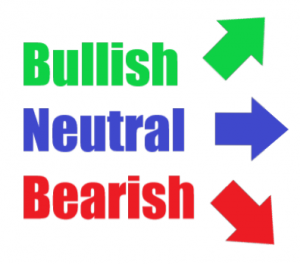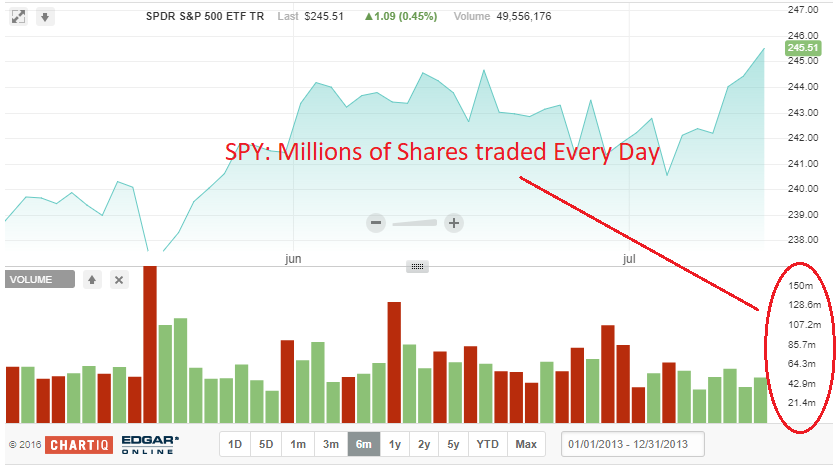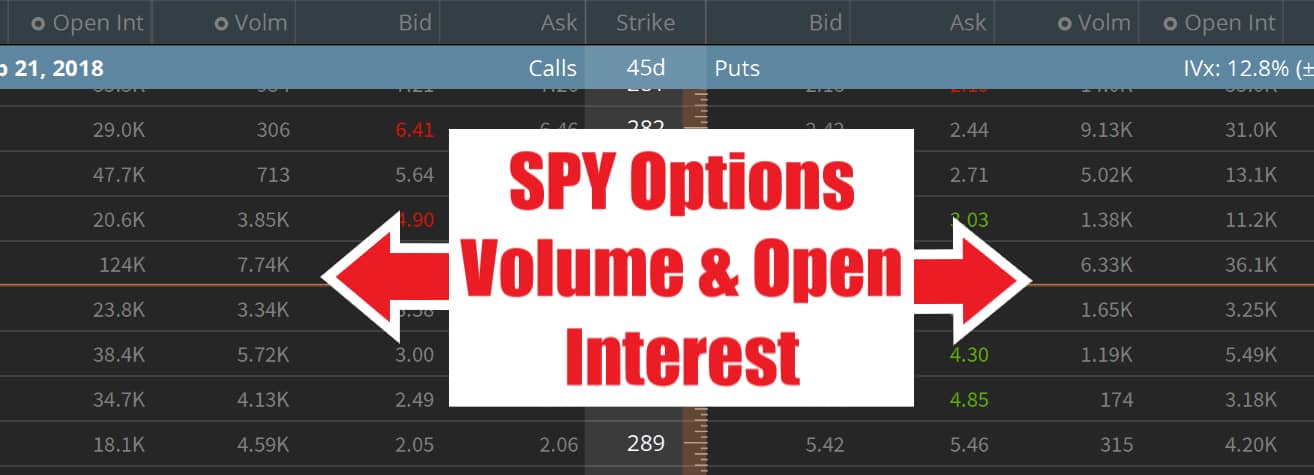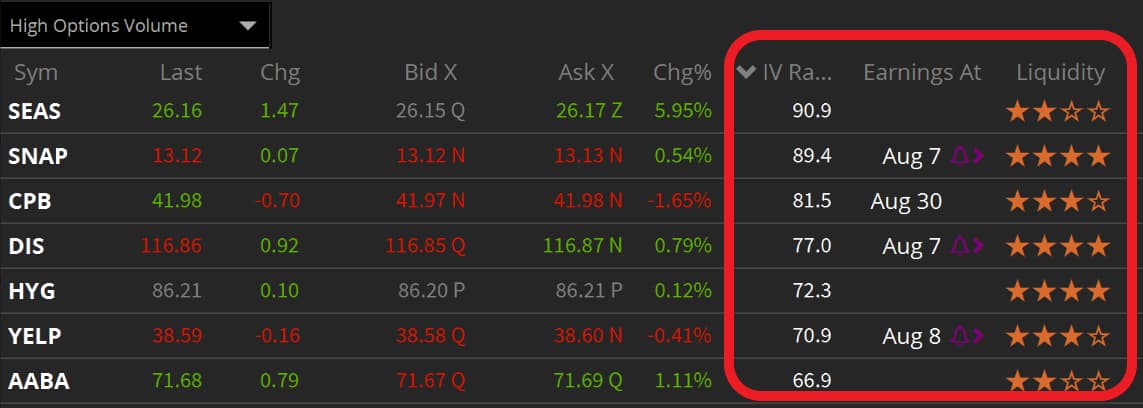Finding new trades and setups can be one of the hardest and most time-consuming things for many trading systems. This is luckily not too hard for high probability options selling. If finding trades isn’t hard, trading won’t take a long time and that is also why you can trade like this with limited time and a full-time job. In this article, I will discuss what you should look out for when searching for new setups.
 Step 1: What Do You Need The Trade For?
Step 1: What Do You Need The Trade For?
First of all, it is important to know what kind of trade you are looking for. There are multiple aspects to consider when deciding on this. Probably the most important one being your current portfolio.
If you have a bigger account, you will most likely have multiple positions open at a time. When you have multiple positions open at once, you should try to have a relatively neutral and diversified portfolio. I discuss this in much more detail in my advanced course.
An overall neutral and uncorrelated portfolio is very important for bigger accounts. Therefore, when opening new positions you should consider your current portfolio. If you have many bullish positions, then look for a bearish position and vice versa. Always try to add positions that make your entire portfolio more neutral.
After looking at your portfolio, you should roughly know what trade to look out for. If you have a smaller account with only very few positions open at once, the aspect of a neutral and diverse portfolio isn’t as important.
Nevertheless, I still recommend selecting a strategy before searching for specific underlying assets to trade. I normally do this and the reason for that is that different strategies need different setups. For instance, a credit spread requires different conditions than a calendar spread.
Statistically speaking, implied volatility has been overstating actual volatility. This means that generally speaking, options have been too expensive. So if statistically, options have been too expensive, then option sellers have had a slight edge because they were selling these overpriced options.
That is also why we want to focus on option selling and not on option buying. Therefore, you should ideally pick an overall short strategy (a strategy that focuses on options selling). Here are a few examples of such strategies:
- Short Strangles
- Short Straddles
- Short Iron Condors
- Credit Spreads
- …
Step 2: How To Find An Actual Underlying Asset
After you chose an option strategy, it is time to find an underlying asset to trade that strategy on.
High probability options trading does not require you to look at hundreds of assets and their charts. You don’t have to find specific chart patterns or anything of that kind. That’s because high probability option selling is based on probabilities, statistics and the overstatement of IV, whereas many other trading styles are based on technical analysis.
You can definitely use technical or even fundamental analysis to form a directional bias on an asset. But technical analysis shouldn’t necessarily be the only or the main factor for an option trade.
Even though you don’t have to look for specific chart patterns, you still shouldn’t trade options on any underlying asset. There are some criteria that should be met.
Here is a list of the most important criteria that an underlying asset has to fulfill:
- Enough Liquidity: Liquidity describes how easy or hard it is to open a position in an asset without affecting its price. The more liquid an asset is, the better. It can be detrimental to your success as a trader to trade illiquid assets. To find out how liquid an asset is, you can look at the volume and the Bid/Ask spread. Liquid assets have very tight Bid/Ask spreads and high volume (millions of shares traded per day). If an asset does not seem very liquid, ignore it. An example of a very liquid asset is the ETF SPY. As you can see on the image below, SPY has a daily volume of many million.

- Liquid Options: Don’t only look at the liquidity of the actual underlying asset. Also look at the liquidity of the options. An options trader wants to trade options and therefore, the liquidity of the options is even more important than the liquidity of the underlying asset itself. Normally, options are less liquid than the underlying asset. So before setting up a trade, it is important to look at the volume, Bid/Ask spread and open interest (number of outstanding contracts) of the options on an asset. Don’t trade illiquid options!

- Availability of Options: Another important factor to check is the availability of options. Does the underlying even have options? If yes, how many? If an underlying only has options with unpractical expiration dates or only with a few strike prices, the opportunities are limited.
Also, make sure that the options aren’t too expensive for your account. If you have a small account, you probably can’t afford to trade all option strategies on all assets without taking too much risk. So people with small accounts also have to take the option prices into consideration.
- Implied Volatility (IV): Always look at the implied volatility of an asset. Some strategies profit from increasing IV and others profit from decreasing IV. Thus, the ones that profit from increasing IV should be entered when IV is low and those that profit from decreasing IV should be entered when IV is high. Usually, option selling strategies should be entered when IV is high because they have a negative Vega (meaning that they profit from decreasing IV). The opposite is the case for option buying strategies. To find out if IV currently is high or low, use IV Rank.
As we are focusing on option selling strategies, we want an asset with high implied volatility (IV Rank over 50).
The broker Tastyworks displays IV Rank directly next to the ticker symbols which is very useful. If you are interested, you could check out my Tastyworks review.
- Upcoming Events: Last but not least, you should look at upcoming events like earnings, dividend payments etc. If not factored in, these events can often ruin an otherwise perfectly good trade. Prices often tend to move differently near and during these and other special events. So if you aren’t planning on trading a specific earnings strategy, try to avoid underlying assets that have earnings or something similar coming up. Many brokers (including Tastyworks) allow you to see upcoming events directly in the broker platform. Otherwise, you could also do a quick google search of the ticker or check the current and upcoming events/news on sites like Yahoo Finance, Google Finance, MarketWatch…
Checking all these things is very important and may seem like a lot of work. But it really isn’t a lot to do. To prove that, I want you to take a closer look at the following image displaying one of the default watchlists in the broker platform Tastyworks.

As you hopefully can recognize, ALL of the above-mentioned criteria and more can be read directly from this tab. Everything from IV Rank, upcoming earnings, liquidity and more is displayed right there.
Step 3: How To Set Up The Trade
Now you should have chosen an option strategy and a fitting underlying asset. The next step is to set up your trade.
How you set up your trade totally comes down to the chosen strategy and personal preferences.
The strike selection will impact the risk profile of your strategy. There isn’t necessarily one correct way of setting up different strategies. If you have a bigger account, you will be able to choose different strikes than someone with a smaller account.
The strike selection should also be affected by your directional bias and approach. Different strategies can be set up more and less aggressive.
Another customizable factor is the time until expiration. This can also vary a lot. However, a good time frame for option selling strategies like the ones mentioned earlier is 40-50 days until expiration. Setting up these strategies at this time frame will allow you to take advantage of accelerating time decay.
As a rule of thumb, you should never risk more than 5% of your total account capital on a trade. So keep this in mind when setting up your strategy.
Every trade can go against you and therefore, it is very important to not risk too much on a single trade.
The potential risk and reward of a strategy can be adjusted by changing strikes, time until expiration and number of contracts.
As this trading system focuses on selling options, you will take in a credit when opening a trade. This credit equals the max profit for most short option strategies. Therefore, make sure to not take in a too small credit. Even in small accounts, it is not really worth it to only take in a very small credit. Ideally, you should take in at least $0,5 – $1 per contract.
Step 4: What Is Your Plan?
Before you send out an order, you should have a trading plan in mind. You should know when to take profits, cut losses and/or adjust the position…
This does not have to be insanely advanced. For instance, a good trading plan for an iron condor position might be:
- Take profits at 50% of max profit
- Close position one week before expiration if one of the sold options is too far ITM
The reason why it is wise to take profits early is that this will increase your win rate and decrease your time in a trade.
Defined risk option strategies such as iron condors don’t necessarily need to be managed a lot. If you keep your risk in check, you can just hold on to these strategies even if they go against you.
But it could be a good idea to close such a losing position if one of the short options is far ITM and has no or only little extrinsic value left. If this is the case, the probability of getting assigned isn’t low.
Undefined risk strategies like straddles, strangles etc. require a more thought-out trading plan because they have unlimited risk. So you should definitely have a concrete plan of what to do if an undefined risk trade goes against you. Furthermore, undefined risk trades need much closer monitoring. You can’t open an unlimited risk trade and just leave it on without ever checking it.
It is very important to create this trading plan before you enter a trade. The more concrete the plan is, the better. It isn’t a bad idea to write down your trading plan so that you can’t forget it.
Step 5: Selecting A Price And Pulling The Trigger
If you have done all of the above, you will have to select an order type and potentially a price to order at. I always recommend using limit orders as these allow you to choose a specific price to order at. Market orders are a different order type that don’t allow you to select a specific price. Market orders will usually get filled faster but at worse prices. Therefore, I recommend using limit orders only.
After doing this, you are finally ready to review and double check the setup one last time. If everything is correct, you are ready to send the order.
Recap
Finding good options trading setups requires you to look at a multitude of different things. Here is a short recap of each step:
- Find out what position your portfolio needs
- Select a strategy
- Find a liquid underlying asset with enough liquid options and the correct IV level
- Check if the option’s prices aren’t too high for your account size
- Look up if the asset has any important upcoming events like earnings
- Select the strike prices and an expiration date (set up the trade)
- Create a trading plan and go through all potential scenarios in your head
- Double check everything
- Send a limit order with the correct price
Hopefully, this article helps you with how to find new potential option trades. If you have trouble understanding certain things covered in this lesson, please let me know in the comment section below!
Throughout this article, you may have noticed that Tastyworks’ broker platform can be very useful for options trading. If you want to learn more about Tastyworks and its features, you should check out my Tastyworks Review.
This Article is part of the Intermediate Option Trading Course. If you are reading the article as a part of the course, you can continue to the next lesson: HERE

Hello,
I picked your post hopping to learn a bit about option trading basics even though your post is about finding new trades. In that sense, you go right into the subject and it’s very technical. you describe all the steps with thorough explanations. I really like the fact that you provide a recap of all the steps at the end of the post. my critic is if you’re not a a seasoned option trader it’ll be hard to follow the explanations. Otherwise it’s very good material. I have some knowledge in forex and stock trading. Options is kinda the last boundary for me. If it ever crosses my mind to try it, I’ll know to come to your site to get good training if you allow.
thanks for a well documented site.
Thanks so much for the feedback.I really appreciate it. I can completely understand that this post may be a little hard to understand for beginner option traders. I guess you weren’t reading the article as part of the intermediate course. This article is actually part of a course. In total I currently offer three courses starting with beginner and ending with advanced. So beginners should ideally start with the beginners course. If you want to check out the courses, you can see their outlines, HERE.
Hi Louis,
Thanks for your post on this. I thought I knew a thing or two about options and then I read your really informative article and realized I need to go back to school on this topic. Really insightful but it highlighted that as a beginner, there are a few more fundamentals I would need to understand in order to invest more in options. Thanks again for the article!
Cheers
James
Thanks for the comment!
I recommend starting with the beginner course. All the basics and fundamentals are explained there. Access it HERE.
Hi Louis,
First of all what a excellent website! It’s packed full of great information on options trading and a must read for anyone looking to learn more about trading options.
I did a little options trading in the past but only on a demo account with Optionsxpress. I was placing itm covered calls and had some great results.
I currently don’t have a large enough amount of capital to start trading for real but could I start with a small amount first and build up my capital?
Thanks
Hey Christian,
Thanks so much for the kind feedback. I really appreciate it!
Starting with limited capital trading is a great idea. On the one hand, it is a great way to get used to trading with real money without risking too much and on the other hand, it is possible to grow the account size. Nevertheless, you shouldn’t expect too much. You won’t turn a $2000 account into a $100 000+ account with simple options trading anytime soon.
That said, you can always add more money to an account later down the road. It’s a good idea to test out strategies with a smaller account. Rather start with a small account than with a too big account. Never risk risk money that you can’t afford to lose.
Paper/virtual trading is also a great way to try out some strategies. But there is still a difference between risking real and paper money.
Hopefully, this helps. If not, please let me know!
This is really cool.It has always been a goal of mind to quit my regular job and make a full time income as a stock trader.
I know that is easier said than done though lol. I have been saving up my money so i can invest it, but I just don’t know the fundamentals of stock trading yet.
So i have been reading books and articles on stock trading trying to learn everything that I can. I am glad i came across this article because it is exactly what I was looking for. Do you have any recommendations on where I can learn more about stock trading. Great article, I am definitely going to share this on Facebook.
First of all, thanks for the comment. It is a really wise decision to educate yourself and save some money. Most people just get started right away without knowing anything. That is a big mistake!
There are many great resources that could help you become a better trader. I actually have a seperate article on different trading resources for people like you. So make sure to check out my trading resource page.
Your teaching style is very clear and concise, I have understood options trading clearer than other sources.
At last, the penny has dropped.
The only query I have at this given time is that most of the stocks are below the rank of 50.
How is it possible to have a lot of trades and keep your portfolio balanced?
There doesn’t seem to be a lot of selling opportunities at the moment.
What strategy would you suggest in this financial climate?